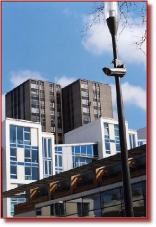 |
||
 |
||
![]()
![]()
![]()
![]()
![]()
![]()
![]()
![]()
![]()
![]()
![]()
![]()
![]()
![]()
![]()
![]()
![]()
![]()
![]()
![]()
![]()
![]()
![]()
![]()
![]()
![]()
![]()
![]()
IMPORTANT: No material may be reproduced, copied or redistributed from this site, without the express written consent of doktorjon.co.uk
All the detailed information on this site is provided in good faith; and as such, Doktor Jon does not accept responsibility for any consequential loss, injury or disadvantage resulting from any individual or organisation acting on the details contained herein.
© doktorjon.com 2004 - 2010
Let’s start with the basics first - every video surveillance (CCTV) security system is capable of fulfilling one or more of the four discreet functions, which are represented by the acronym ‘DISE’.
D = Deterrence, I = Incident Monitoring,
S = Site Management, E = Evidential Recording.
In relation to the way that each objective can be employed, Deterrence and Evidential Recording are essentially ‘passive’ functions of a CCTV system; that is to say, in most situations they do not require the input or control of an operator, in order to be highly effective.
It’s also useful to remember that the mere presence of a CCTV installation may well be intended to provide a measurable deterrent effect towards certain types of crime, irrespective of whether there is an observer watching the monitor or not (but more about deterrence later).
Likewise, with public area CCTV, positive publicity through the Press and media can very often suggest a far greater ‘enhanced’ deterrent effect, than the mere presence of the installation itself.
Conversely, Incident Monitoring and Site Management almost always require the efforts of an operator to be successful, and for this reason, these functions are generally regarded as being ‘active’.
As a general rule of thumb, active camera systems typically cost around four to six times as much as a passive configuration, and that’s without taking account of the ongoing staff salaries.
Now hang on a minute, if it costs so much money to install remote control cameras in public areas like Town Centres, is this really money well spent, or are there cheaper, and dare I say more effective alternatives?
Guess what ..... the answer is an emphatic YES!
Statistically, on average, the chances of spotting a crime in progress (Incident Monitoring) using a multicamera remote controlled ‘active’ system, are actually very very small; in fact my early calculations back in the late '80's suggested only perhaps a 2 - 4% chance on average (per camera) of catching a crime or incident in progress, using a multi camera "Town Centre" or Public Space Surveillance (PSS) type system.
Looking at the overall number of incidents in a given CCTV monitored area and the number of actual arrests or identifications that result with an average system, these early estimates appear to be borne out by recent practical experience.
Conversely, the chances of recovering Evidential Quality Recorded images of suspects from a correctly configured ‘passive’ system are ..... surprise, surprise, extremely high - again earlier estimates based on work carried out by DJ in the '70s and '80s would suggest a successful capture in perhaps 70 - 85% of situations where the cameras have been correctly optimised.
More detailed information on the DISE Principles >>>

So now we’re up to step 3 - the CCTV System Profile, which as far as Doktor Jon is concerned, is perhaps the most crucial step towards designing and deploying an effective and efficient video surveillance system; mind you, if the truth be told, it probably wouldn't be much use without first having carried out the first two earlier stages.
Having collated the Crime Audit ( CA - both global, macro and micro), and carried out a thorough Risk Assessment Survey (RAS), it’s now come to a point where you have to try and make sense of all this raw data, and for that you need to prepare a System Profile (SP).
![]()
![]()
![]()
![]()
![]()
![]()






